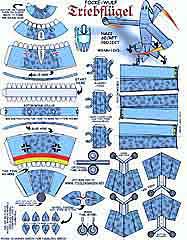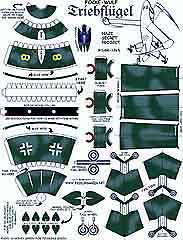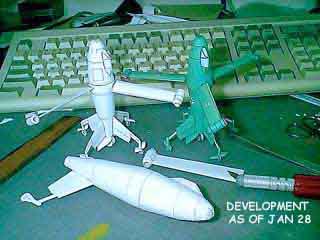
Triebflugel X-plane - $$5.95
It had no wings, and all lift and thrust were provided by a rotor/propeller assembly in the middle of the craft. When the plane was sitting on its tail in the vertical position the rotors would have functioned similarly to a helicopter. When flying horizontally they would function more like a giant propeller.
The Focke-Wulf Nazi X-plane,Triebflugel

 In 1944, at Focke-Wulf, Professor Otto Pabst worked on an interesting fast vertical takeoff aircraft named the Triebflugel. Its purpose was to rise quickly from just about anywhere and attack the allied bombers.
In 1944, at Focke-Wulf, Professor Otto Pabst worked on an interesting fast vertical takeoff aircraft named the Triebflugel. Its purpose was to rise quickly from just about anywhere and attack the allied bombers.
Similar to a helicopter, it was powered by THREE large wing-like rotors but unlike a helicopter, the rotors turned around the fuselage. To preclude fuselage torque, the rotors were powered by small ramjets mounted on the tips and these were to be boosted to start speed by rockets. The landing gear casters in the tail were retractable.The use of the ramjet made it possible to use various cheap fuels.
The big problem consisted, however, in passing from the vertical flight to the level flight and back. The landing presented a particularly delicate moment because the pilot did not have good rearward visibility because of revolving airfoil. One wonders how he/she would have bailed out.
I have just finished Fiddlers Green's Triebflugel. I want to congratulate Chip for releasing this model and Chauncy Green for such a wonderful design. The model went together very well which is a credit to the design effort that went into this. Since the model is approx. 1/75 scale it will fit in with the 1/72 collection I am doing. If you have not got this model yet, get it, it's well worth the time it will take to build it. Saul (FEB 3)
One would tend to think that all three-view technical drawings and profiles of the same plane would be the same... one would be wrong. It's surprising how much these thing vary. I'm not just talking about small details either, the actual part shapes and proportions are noticeably different and once an inaccurate drawing is published, it is often picked up upon by others and repeated.
As if that weren't enough, I have one book of WW2 period scale drawings that states that one guy's work was too accurate for the War Department's liking, so he had to go back and change the shape of certain things. They warned the reader about the B-29 vertical tail, but who knows what others there are? Chauncy Green
Without doubt, one of the most unusual fighter projects
to be devised during the life of the Third Reich was the Focke-Wu lf
Triebflugeljager (rotating wing fighter) created by Professor
von Holst and Dr. Kuchemann, of the Gottingen Technical University.
Erich von Holst had participated at the Saalflugwettbewerb (Indoor
Flying Scale-Model Competition) held at Breslau in 1940, where
he demonstrated his model, identified as the Libelle (Dragonfly).
he also referred to his creation as the Schwingenflugzeug Ornithoper,
flapping wing aircraft). After investigating several different design approaches, he published his findings in the
"Jahrbuch der Luftahrtforschung" (Aeronautical Research
Annual) of 1942.
lf
Triebflugeljager (rotating wing fighter) created by Professor
von Holst and Dr. Kuchemann, of the Gottingen Technical University.
Erich von Holst had participated at the Saalflugwettbewerb (Indoor
Flying Scale-Model Competition) held at Breslau in 1940, where
he demonstrated his model, identified as the Libelle (Dragonfly).
he also referred to his creation as the Schwingenflugzeug Ornithoper,
flapping wing aircraft). After investigating several different design approaches, he published his findings in the
"Jahrbuch der Luftahrtforschung" (Aeronautical Research
Annual) of 1942.
Beginning in 1943, Focke-Wulf actively tried to find a reliable method of increasing the thrust of a conventional Lorin ramjet, following Dr. Sanger's research that proved this type of propulsion to be the most efficient way to accelerate advanced fighters. Dr. O. Pabst, head of Focke-Wulf's development department, and Dr. Ing. Theodor Zobel, his most experienced colleague, had designed an engine that had a reduced drag coefficient due to it's clean shape.
 By March 1944, at had been ascertained that the Lorin ramjet
would work efficiently up to altitudes of 59,000 ft.
Another advantage of the system was that cheap fuels and oils
worked well. The first test model was finished in August 1944,
but testing was delayed several months due to Allied air raids.
It was impossible to complete certain essential sections, and
the promised fuel was not available in time. During July 1944,
the OKL had decided that four airworthy Lorin ramjets would
be built by August 1945. Also in 1944, Focke-Wulf engineers had
designed a Lorin ramjet powered Strahlrohr-Bomber (Lorin ramjet
bomber), followed by a fighter bomber and some designs of fast
fighters.
By March 1944, at had been ascertained that the Lorin ramjet
would work efficiently up to altitudes of 59,000 ft.
Another advantage of the system was that cheap fuels and oils
worked well. The first test model was finished in August 1944,
but testing was delayed several months due to Allied air raids.
It was impossible to complete certain essential sections, and
the promised fuel was not available in time. During July 1944,
the OKL had decided that four airworthy Lorin ramjets would
be built by August 1945. Also in 1944, Focke-Wulf engineers had
designed a Lorin ramjet powered Strahlrohr-Bomber (Lorin ramjet
bomber), followed by a fighter bomber and some designs of fast
fighters.
According to Focke-Wulf's overview, the Triebflugeljager had the following advantages: high efficiency, low fuel consumption, light weight, and a high ceiling; furthermore, it's engine would run on any combustible medium, gaseous or liquid, which could be vaporized. In the case of engine failure, three HWK rockets would ensure a safe landing.
The most important theoretical work on the Triebflugeljager was contributed by Dipl-Ing. Flugbaumeister Heinz van Halem, a highly qualified and gifted engineer. He had joined the Focke-Wulf development department in the summer of 1944, becoming part of a team of experienced designers and engineers. The Triebflugel was an aircraft whose wings were replaced by three airfoil-shaped rotor blades, each with a ramjet propulsion unit at it's tip. The pitch of the rotors could be adjusted by the pilot. At the top speed of 453 mph (730 km/h), normally used only during the climb, the rotating velocity of the ramjets would be much higher than the aircraft's forward speed. In this manner, efficient functioning of the ramjets would be ensured even at low air speeds. The greater the forward speed of the aircraft, the slower the rotation of the wings, and the smaller the difference between ramjet speed and airspeed.
For takeoff, the aircraft stood vertically on it's main wheel located in a pod at the tip of the rear fuselage, while each of the cruciform tail planes also had smaller auxiliary wheels. For initial wing rotation, Three Walter rockets were ignited, one in each ramjet. When the correct rotation speed was reached, then the ramjets would start, whereupon the smaller rockets were shut down. During this stage, the wing pitch was neutral, when they were moved to fine pitch, lift was generated to the aircraft, due partly to the rotation of the wings, and the ramjets' thrust being parallel to the longitudinal axis of the fuselage.
After climbing and leveling off, course pitch was applied and rotation speed reduced accordingly, in order to maintain a constant speed at the wing tips of 683 mph. At the maximum design speed of the fighter, the wings rotated at 220 rpm. To land, the pilot had to rotate the aircraft while switching the rotor pitch, enabling the aircraft to vertically descend to it's takeoff position. During all flight regimes, the pilot seat remained fixed in one position. This meant that he was in a reclining position during takeoff and landing. It is interesting to contrast this approach with that of the American VERTOL (Vertical Takeoff and Landing) Convair XFY-1, Pogo, of 1954, in which the gimbal-mounted pilot's seat rotated forward 45 degrees, thus enabling the pilot to fly the aircraft from a more conventional position while it was taking off or landing.

|
 Wayne's usually quick like a rabbit to send us photos of new releases. So quick is he, that these were ready BEFORE the models were even released! |
 |
Unfortunately for the Focke-Wulf VERTOL fighter project, development was interrupted when the Chef TLR ordered termination of all project under development that required more than a few months for completion. Only the Bachem Natter escaped this cutback. It is interesting to note that, Triebflugel fighter development seemed so promising to the western Allies that Pabst's and Zobel's reports remained classified by the Americans until January 1955.
The Attack X-plane Focke-Wulf Triebflugel, conceived by Heinz von Halem in September 1944, was a very interesting study of rotary wing flight and had some very unusual characteristics indeed. The Triebflugel sat vertically on the empennage and obtained its upward push by three wings in rotation around the fuselage. These rotary wings was positioned roughly a third length of the fuselage starting from the nose.
 No torque was transmitted to the fuselage by the wings since
they were propelled by three ramjets affixed to the ends. Below
the speed of operation of ramjets 186 mph, the wings were put
into rotation by three booster rockets Walter (660 lb of thrust)
assembled in the nacelles of the ramjets. The great advantage
of this design was the plane was to be able to take off vertically
at a high vertical speed from just about anywhere. Each ramjet
would have been 2 ft. to 3 in diameter, give approximately 1,850
lb of thrust and was developed from the tests led since 1941 by
Otto Pabst in the department of Gas Dynamics at Focke Wulf, in
Bad Eilsen.
No torque was transmitted to the fuselage by the wings since
they were propelled by three ramjets affixed to the ends. Below
the speed of operation of ramjets 186 mph, the wings were put
into rotation by three booster rockets Walter (660 lb of thrust)
assembled in the nacelles of the ramjets. The great advantage
of this design was the plane was to be able to take off vertically
at a high vertical speed from just about anywhere. Each ramjet
would have been 2 ft. to 3 in diameter, give approximately 1,850
lb of thrust and was developed from the tests led since 1941 by
Otto Pabst in the department of Gas Dynamics at Focke Wulf, in
Bad Eilsen.
Ram Jets are basically simple cylinders that operate as jet engines only when they pass through the atmosphere at high speeds. The compressed air acts as the compressor. Pabst had developed successfully a ramjet with a total length two and a half times the the diameter, which gave suitable propulsion for a rotational movement of the 'wings'. The starting rockets located in the ram jets were to rotate the blades up to mach .9 to allow the jets to kick in.
Another significant advantage of the ramjets was their capacity to operate on low quality fuel- a solution to the problem Nazi Germany faced more and more towards the war's end.
Das Triebflugel rested vertically on the ground, supported by its leg landing gear PLUS one main wheel..Each comprised of a spreadable housing with a wheel at its end. During the flight the wheels retracted into the nacelles. The pilot was positioned prone in the cockpit with a bubble canopy. This provided a more streamlined smaller fuselage cross section as well as making the would be pilot more comfortable not having to sit in messy pants that he surely would have had flying this little puppy. Armament was placed in the unobstructed the nose and consisted of two 20mm machine guns of 20 mm and two or 30mm.

|
(we know nothing....just report it) Sorry, the Great Hairy Paw and I disagree with that article 100%. The power source was to be three JUMO turbojets, a sawed off version of the same engine powering the ME-262. Now, how the fuel was to be
fed out to
Since no successful coleopter has ever flown (A French
Job managed to get off the ground, but became totally unstable while attempting
to
That thing would twist and turn in unpredictable directions as soon as you tried to transition to horizontal flight ...possibly a computer-aided fly-by-wire system could do it, but doubt pure mechanical controls would have been effective.
|
 |
 |



The "Spinwing" is the world's first and only flying "stop-rotor" aircraft. This extraordinary machine has the remarkable ability to slowly or rapidly convert between helicopter and airplane flight modes and can therefore realize the benefits of both hovering and horizontal flight. It does not require prepared landing areas yet is able to sustain long endurance flight profiles at high dash speeds. In effect, the Spinwing combines the advantages of the helicopter and the airplane while avoiding their limitations. The Spinwing was invented by the creative mind of W.R. "Randy" McDonnell of Advanced Aerospace Technologies Inc. (AATI) and is being further developed in a collaboration between AATI and its partner, the Thorpe SEE-OP Corp. of Mesa, Arizona. During hovering flight, the tail wings are driven much like a helicopter rotor, and the main wings counter-rotate to offset the consequent torque. During horizontal flight, the main and tail wings operate like conventional aircraft wings, and a pusher propeller drives the airplane forward. Flight tests were completed on a concept demonstrator in St. Louis, Missouri, during the summer of 1996, and further testing of technology demonstrators has continued into 1999 in Mesa. The potential uses of this R/C aircraft include search-and-rescue missions and a wide variety of environmental, research and law-enforcement applications. Studies are under way to assess scaling options for larger Spinwing craft. To see images of prototypes in flight as well as AVI videos of flight-mode conversions, visit the Spinwing website at www.seeop.com.
|





